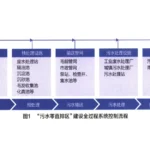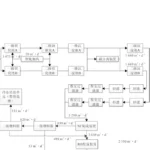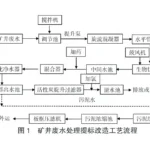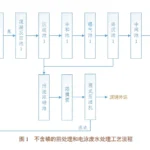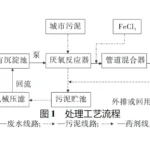outlined
The flue gas desulphurisation system of the power plant unit adopts limestone-gypsum wet desulphurisation process, and the desulphurisation wastewater generated by the system is transported by transfer pumps to the first and second phase desulphurisation wastewater treatment station respectively. The designed capacity of the unit phase I FGD wastewater is 67.3t/h, and the designed capacity of the phase II FGD wastewater is 2×36t/h, with one use and one backup. The phase II FGD wastewater system includes the following three sub-systems: FGD device wastewater treatment system, chemical dosing system, and sludge dewatering system. The main process flow is as follows: desulfurisation wastewater from desulfurisation island → wastewater pre-settling tank → wastewater buffer tank → wastewater transfer pump → neutralisation tank (adding lime emulsion) → reaction tank (adding organic sulphur) → flocculation tank (adding aluminium sulphate or FeSO4 and coagulant aids) → thickening and clarifying tank → clarifying tank → clarifying pump → dual media filter → clarifier (adjusting pH value) → clarifier pump → reuse after reaching the standard. Sludge circulation pump is set in the pre-settling tank and clarifying tank, and the sludge generated from sedimentation is transported to the plate and frame filter press by the sludge transfer pump for desludging and external transport. Due to the company's first phase of desulfurisation wastewater is in the period of shutdown and reconstruction, a period of equipment can not be put into operation normally, a unit of desulfurisation wastewater generated by the second phase of desulfurisation wastewater system needs to be discharged to the second phase of the desulfurisation wastewater system to be processed, so that the original design of a system of one operation and one standby system has become a two sets of normal operation system, increasing the maintenance and operation of the personnel workload. Meanwhile, since the FGD wastewater system was put into operation, abnormal problems such as equipment blockage and mud-bearing water often occurred, which caused difficulties in the operation of FGD wastewater system and increased the safety risks and work intensity in operation and maintenance, etc. In order to solve the problems mentioned above, the relevant technicians of the company analysed and solved the problems of FGD wastewater of the second phase.
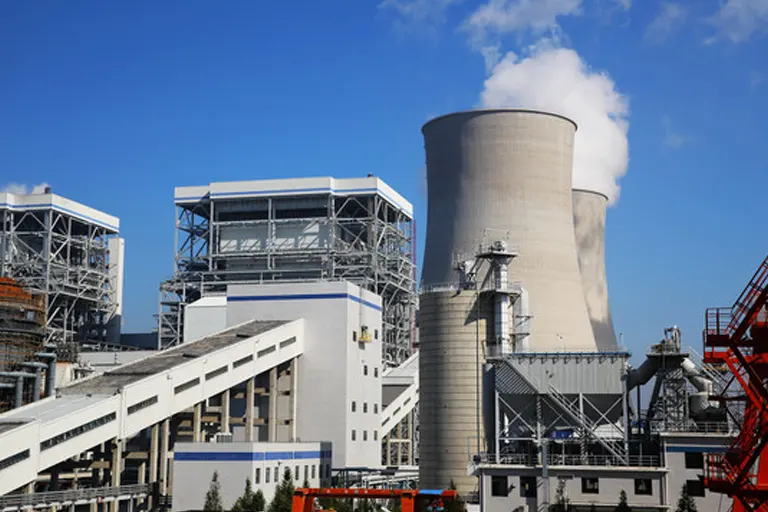
1 Problems with desulphurisation wastewater systems
At present, the main problems of the second phase of desulphurisation wastewater are summarised as follows: Firstly, the wastewater treatment pre-settling tank is silted up, and the pre-settling tank scraper is out of operation due to faulty shutdown, which prevents it from operating normally. Second, the buffer pool aeration fan abnormal, fan noise, current rise, over current forced to shut down. Third, the desulfurisation wastewater sludge removal system of each mud pipeline is often clogged, when serious, resulting in pipeline connecting flange holding pressure bared mud, resulting in pollution of the surrounding environment, desulfurisation wastewater system was forced to shut down. Fourthly, the dosing pump and dosing pipeline of the triple box lime milk dosing system are often clogged, resulting in a reduction in the output of the lime milk dosing pipeline, and the amount of lime milk dosing of wastewater treatment fails to meet the design requirements. Fifth, the plate and frame filter press compressed mud cake is not shaped or the mud is bared between the filter plates of the filter press, resulting in pollution of the surrounding environment, and in serious cases, the plate and frame filter press is forced to stop operation. Sixthly, the two sets of plate and frame filter presses set up in the desulphurisation wastewater system are controlled by the mother, which cannot operate flexibly, the equipment utilisation rate is low, and the efficiency of sludge removal has not been brought into full play effectively.
2 Analysis of causes
2.1 pre-settling tank blockage reasons First, the design of desulfurisation wastewater treatment wastewater solids content requirements for less than 0.8%, team members of the second phase of the desulfurisation wastewater system water sampling and observation, found that the solids content of the incoming water samples is not stable, more often, wastewater solids content of the incoming water is far more than 0.8%, exceeding the capacity of the existing system wastewater treatment may result in pre-settling tank clogging. Secondly, there are foreign materials in the pre-settling tank, causing the tank body scraper jamming, scraper stop running, pre-settling tank silt deposition, and ultimately clogging.
2.2 The fan is forced to stop running because one is that the fan lubricant is not qualified, resulting in damage to the fan bearings and high noise. Secondly, the aeration fan inlet screen is blocked, resulting in increased resistance to fan operation, increased load, reduced air volume, and motor overcurrent. Third, the aeration fan outlet pipe is blocked, resulting in fan holding pressure, current increase, and ultimately over-current tripping.
2.3 Causes of holding pressure bared sludge and water reasons First, the sludge conveying pipeline arrangement is unreasonable. Team members observed the site sludge conveying pipeline, including pre-settling tank, clarification and thickening tank sludge circulation pipe, conveying pipe arrangement is more complex. Secondly, the sludge conveying pipeline flushing frequency is low or the flushing effect is poor resulting in pipeline clogging, holding pressure, and ultimately the flange gasket breaks, resulting in the phenomenon of mud and water.
2.4 Pipeline clogging causes one is the lime milk dosing pump import and export pipeline lining off, resulting in pipeline clogging. Secondly, the milk of lime solution box is set as a single-layer stirring impeller, the stirring is not sufficient, which is easy to cause the milk of lime to be clogged at the bottom of the solution box at the exit pipe. Thirdly, check the serious clogging inside the milk of lime pipeline, pipe scale accumulates along the inner wall of the pipe in layers, gradually reducing the diameter of the pipe, resulting in a gradual decrease in the dosage of the system. Analyse and observe the composition of the pipe scale, and found that the scale is milky white in appearance, similar to ceramic, insoluble in acid, and analysed mainly as calcium sulphate. Milk of lime dosing using desulphurisation wastewater tank water, the water source exists in a certain amount of sulphate ions, and calcium ions in the milk of lime to react to produce calcium sulphate, and ultimately clogging the pipe. Fourthly, the low frequency and poor effect of lime milk pipeline flushing, resulting in the accumulation of lime milk in the pipeline, and ultimately clogging the pipeline.
2.5 Plate and frame filter press stopping reason is that the quality of filter cloth of plate and frame filter press is poor or the washing of filter cloth is not thorough, resulting in poor sealing of filter cloth between filter plates, thus mud and water are bared. Secondly, the water outlet hole of the plate and frame filter press is blocked, and the wastewater through the filter cloth cannot be discharged smoothly, which ultimately causes excessive pressure in the chamber between the two filter plates, resulting in the deformation of the filter cloth and the emergence of muddy water. Third, the second phase of desulfurisation wastewater set up pre-sedimentation tank, pre-sedimentation tank part of the internal precipitation of sludge with the sludge conveying pipeline together with the filter press, due to the pre-sedimentation tank sludge has not been dosed, the sludge can not complete the complex reaction to form a more stable complex, the existence of static charges on the surface of the sludge has not been eliminated, resulting in the sludge is difficult to be compressed into a mud cake in the plate and frame filter press, resulting in the final cake is not shaped or bared water phenomenon. Or the phenomenon of bare mud and water. Fourthly, the plate and frame filter press bares mud or unloads mud during the period often causes sludge on the ground between the plate and frame on the first floor, and the sludge pressed into square cake shape falls directly from the open cavity of the filter plate to the flat steel support of the sludge discharge hopper, the sludge splashes in all directions, and it scatters in the gap around the sludge discharge hopper on the ground floor to pollute the ground and wall of the sludge discharge room. As the sludge of the plate and frame filter press has a certain degree of viscosity, once the wall and floor are polluted, it is more difficult for the staff to clean up.
3 Identification of the main causes
Through the field test analysis, lock the main causes of the problems caused by the system: a pre-sedimentation tank clogging the main reasons: pre-sedimentation tank empty, clean up the internal silt, found that there is a small portion of debris inside the sedimentation tank, but on the operation of the mud scraper has a small impact. Judge the main reason for the pre-sedimentation tank clogging is that the solid content of the incoming wastewater exceeds the standard. Second, the buffer pool aeration fan was forced to stop the main reason: members of the team on the aeration fan lubricant inspection, found that the fan oil quality is good, did not find the phenomenon of unqualified oil, discharged for this reason; members of the team organised to clean up the replacement of the fan filter, but the results achieved are not good, can be discharged for this reason; members of the team to check the fan outlet pipeline, found that the buffer pool inside the aeration pipeline on the aeration holes are blocked by sludge, dredge the aeration holes. After dredging the aeration holes, the fan runs normally. Determine the cause of abnormal fan operation for the fan outlet pipeline aeration holes are blocked by silt caused. Third, the sludge removal system pipeline clogging sludge, resulting in holding pressure bared mud and water main reason: to strengthen the sludge pipeline flushing frequency, will shorten the flushing cycle by half, but the effect is not good, can be checked that this factor has little impact. Analysis of the main reason for the pipeline arrangement is unreasonable, large U-shaped bends caused by sludge is easier to clog, the need to optimise the piping system. Fourth, the milk of lime dosing system equipment, pipeline clogging main reason: often blocked parts of the milk of lime dosing pump outlet pipeline elbow, the dosing pump outlet pipeline material change for UPVC pipeline, but after a period of time, the pipeline is still clogging, can be investigated lining pipeline lining plastic shedding factors. Lime milk dosing pipeline flushing cycle is shortened to general, also did not see significant results, to determine the main reason for the dosing water quality does not meet the requirements.4 Countermeasures to implement a strict supervision and control of desulfurisation wastewater water quality, and desulfurisation operators to do a good job of communicating with the maximum degree of maintenance of desulfurisation wastewater quality of incoming water containing solids in the wastewater system within the capacity of the output. The second is to set up the second phase of desulfurisation wastewater pre-settling tank, buffer pool bypass system, desulfurisation wastewater water directly to the triple box for dosing, the original pre-settling tank and desulfurisation wastewater two clarification and concentration pools in parallel, as a clarification and concentration pool standby. It has been proved that this bypass can meet the requirements of unit desulphurisation wastewater treatment, and at the same time eliminates the demand for pre-settling tank mud discharge and prevents muddy water without dosing and complexing from mixing into the plate and frame machine, resulting in mud and water spraying from the plate and frame machine. Third, the second phase of desulfurisation wastewater pre-settling tank, clarification and thickening tank originally arranged in the underground pipe trench sludge transport pipeline all raised to the ground, the height of the pool to maintain the same sludge pipeline, side-by-side arrangement, direct docking to the entrance of the sludge transport pump, eliminating the original design of the U-bend structure, the transformation of the sludge transport pipeline blockage phenomenon has been basically eliminated. Fourthly, the water source of the second-phase desulphurisation wastewater lime milk solution is changed to industrial water with better water quality, eliminating the reaction between lime milk and sulphate to generate insoluble calcium sulphate, and eliminating the phenomenon of frequent blockage of pipelines.
5 Conclusion
The system optimisation of Phase II FGD wastewater treatment system as mentioned above ensures the safe and stable operation of the system, reduces the equipment failure category and lightens the workload of the maintenance personnel, and at the same time maximises the operating capacity of the Phase II FGD wastewater treatment system, providing a strong guarantee for the stable operation of the unit.
Welcome to call us for consultation, technical exchange, and material experiment.
Enquiry: 188517-18517
 Plate and frame chamber diaphragm filter presses
Plate and frame chamber diaphragm filter presses


